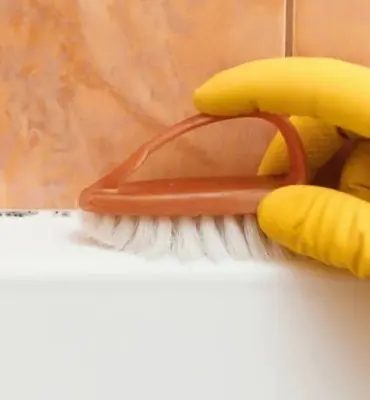How To Clean Grimy Bathroom Floor Corners
Published on Oct 15, 2021

Even the cleanest of bathrooms can be victim to that grimy pile-up in tiled corners. That slimy gunk can be a real eyesore and is notoriously difficult to treat. Forget about ‘miracle’ products. A few items already in your pantry can do a phenomenal job of getting rid of the grime.
Let’s get started.
No time to read? Watch this 2 minute video!
How to clean grime from bathroom floor corners
Corners are a magnet for dirt and bacteria in a bathroom, particularly around the shower recess.
So, why does this happen? The way most mops are designed may push dirt into corner crevices while you’re cleaning and areas like the shower are prone to excess water and moisture, further exacerbating any mould or grime growth.
Here are a few ways you can treat tile grime.
1. Wipe it down

To begin, wipe down any excess slimy looking grime from the problem areas. Removing the slime from the surface will expose any long-term mould and give you an idea of what you’re up against.
2. Make a baking soda tile cleaning paste

Create a paste by combining 2 tablespoons of baking soda, a squirt of dishwashing detergent and around 50mls of water.
Stir until it has a consistency similar to toothpaste – you may need to add more water or baking soda to get the consistency right. My mix looked a little more like shaving cream because I used a touch too much detergent, but it still did the trick.
3. Apply tile cleaning paste on grime-affected areas

Apply a generous amount of your paste to the grime-affected areas, let it sit for up to 30 minutes before giving it a good scrub with an old toothbrush. Wipe the area down well.
Baking soda works so well on this job because its mildly abrasive properties do a great job of lifting grime off porous surfaces.
Best of all it doesn’t have the strong smell of chemicals most people believe are needed to tackle areas like these.
4. Create a vinegar cleaning spray

In a spray bottle, create a diluted mix (1:1 ratio) of white vinegar and water. Carefully spray onto the area, trying to not get any spray on the tiles themselves, particularly if they are natural stone. Leave for 10 minutes and lightly wipe down with warm water.
Vinegar is a great way to naturally treat mould because of its antifungal and antibacterial properties – it is an inexpensive yet effective way of treating smaller mould infestations.
Note
Note that you should only be spraying vinegar on sealed grout as vinegar can penetrate into the spaces of unsealed grout, causing it to deteriorate over time.
5. Repeat the process if necessary

Mould and grime in the corner of a bathroom can be particularly stubborn. If the process above hasn’t achieved the results you want, you can repeat the process at a later date.
If it still isn’t budging, you may need to call in a professional service such as Electrodry Tile and Grout Cleaning to effectively remove dirt, grease and bacteria from your grout.
The Results



Electrodry’s Mould and Mildew Treatment is the ideal solution for grimy bathroom grout that accumulates over time.
It merges our restorative cleaning process with Chlorosan, an anti-microbial stain removal solution designed for mould affected tiles and grout.
Chlorosan actively treats and sanitises the mould affected area, effectively treating stubborn mould stains to reveal healthy and restored bathroom grout.
Extra Tips on How To Keep Your Bathroom Corners Clean
These are a few ways you can ensure that your tiled corners are kept clean in the future.
-
Repeat the above 5 steps at least once a month to keep on top of any emerging mould problems.
-
Reduce how much water you use when cleaning – a spray mop is ideal.
-
Invest in a corner scrubber, such as this one. The corner scrubber’s unique shape means it is able to get into those hard-to-reach places.
-
After a shower or bath, wipe down the tiled areas around the bath or shower recess. Removing excess water could help to minimise future mould growth.